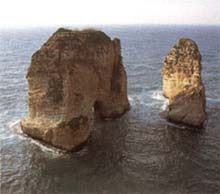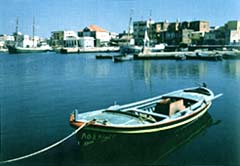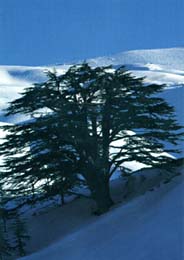
![]()
| Facts About
Lebanon Capital: Beirut Population: Approximately 4 million Monetary Unit: The Lebanese Pound Area: 10,452 square kilometers
Economy: |
|
About 38% of the country is under cultivation, with wheat, vegetables, fruit, tobacco and olives the main crop categories. There is considerable livestock farming as well. Industry ranges from cement and cables to textiles, clothing, furniture, canned goods and light metals. Tourism, one of the mainstays of the pre-war economy, is being revived.
To help strengthen the economy, the authorities have initiated a low income tax schedule to provide investment incentive, increase disposable income and expand the tax base.
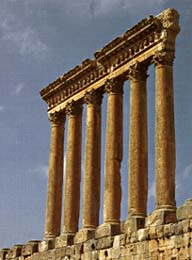
Currency and Banking
Movement of currency into and out of the country and
all exchange transactions are completely free of any kind of control. Gold
and silver coins may be freely exchanged, imported and exported.
The monetary unit is the Lebanese pound issued in L.L.50, L.L.100, L.L.250,
L.L.500, L.L.1000, L.L.5000,L.L.10000,L.L.20000,L.L.50000 and L.L.100000
notes.
Banking is a major industry in Lebanon with strict banking secrecy one of
its important features.
More than 80 banks operate in the country and transactions are performed
efficiently and at low cost.
Baalbeck
Government
Lebanon is a democratic republic with a parliamentary
system of government and
a cabinet headed by a prime minister. Its constitution is based on the separation
of executive, legislative and judicial powers, with a president elected for
a six-year term. The 128 members of parliament are elected by universal adult
suffrage for a four year term. The Lebanese Republic is divided into six
regional administrative districts, or Mohafazaat: Beirut, North Lebanon,
South Lebanon, The Beqaa and Nabatiyeh.
| Geography
and Climate Although a small country, Lebanon's varied geographical areas fall into four features. First there is the narrow coastal plain where five of Lebanon's great historical cities developed: Tripoli, Byblos, Beirut, Sidon and Tyre. The 220 kilometers-long coastline is marked by indentations and rocky outcrops wherever the sub-coastal range joins the sea. The second geographical feature is a |
|
|
| north-south
mountain range known as Mount Lebanon. Appearing at times to rise abruptly
from the sea, Mount Lebanon covers more than a third of the country. Its western slopes are well wooded and are frequently broken by wild valleys. The mountain rise gradually over a distance of some 30 kilometers to the highest peaks of Sannine (2,628 meters) and Qornet es Sawda (3,069 meters). It is Mount Lebanon, or Jabel Lubnan in Arabic, that gave the name to the country. In fact Lebanon owes its geographical unity to this mountainous range which is almost entirely contained within its frontiers. The next of Lebanon's four areas is the Beqaa valley between 8 to 15 kilometers wide and about 120 kilometers long from north to south. A fertile plain east of the Mount Lebanon range between 800 and 1,250 meters in elevation, the Beqaa valley was known as the breadbasket of the Roman Empire in ancient times. Still the major agricultural zone of Lebanon, the central area, is the most fertile while the southern past is less cultivated, being swampy and full of rocks. It is through the Beqaa that the 140 kilometer-long Litani River, the longest in the Lebanon, turns to meet the Mediterranean between Sidon and Tyre. On the eastern side of the Beqaa, the Anti-Lebanon mountains and Mount Hermon rise. A chain of rocky, almost treeless mountains running parallel to the Lebanon range, the Anti-Lebanon is lower but more complete than Mount Lebanon. These mountains form the frontier between Lebanon and Syria. Lebanon enjoys an essentially Mediterranean climate with mild, rainy winters and long summers which are warm and humid. The spring months sometimes witness the so-called Khamseen, a hot, dry wind, but these winds are usually short-lived. |
||
|
Snow Ski and
Water Ski Lebanon is one of the few winter sports centers in the Middle East and certainly the most extensive. The season begins in December and continues until April in a winter landscape surprising in its variety and beauty. The largest resorts have hotels, chalets and other facilities, including good ski lifts. There are six winter resorts: The Cedars (2,300 meters), Faraya/Ouyoun es Siman (1,890 meters), Laklouk (1,740 meters), Faqra (1,750 meters), Qanat Bakiche (1,900 meters) and Zaarour (1,900 meters). Lebanon's long varied coastline and its Mediterranean climate make it an ideal place for water sports. Numerous resort complexes, beaches and swimming clubs have aquatic amusements and sports on offer, including water skiing, surfing, underwater fishing, sailing, scuba diving and snorkeling. |
|
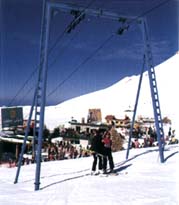 Equipment
for water skiing and scuba diving can be rented from clubs and shops. As
tempting as the seaside is, many more sports opportunities await the visitor.
Tennis, squash and football are all popular. Equipment
for water skiing and scuba diving can be rented from clubs and shops. As
tempting as the seaside is, many more sports opportunities await the visitor.
Tennis, squash and football are all popular.There are fitness clubs where it is possible to work out, as well as groups interested in judo, karate, yoga, gymnastics, parasailing, golf, cycling, canoeing, mountain climbing and potholing. |
||
Museums to
Visit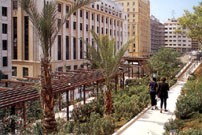
AUB ARCHEOLOGICAL MUSEUM in
Beirut has an extensive collection of
artifacts from Lebanon
and the Near East. |
Lebanon's traditional culinary art combined with the abundance of fresh fruits and vegetables make eating out an adventure. Restaurants specializing in Lebanese food are found everywhere and in all of them you will be invited to try the famous hors-d'oeuvres known as mezze. A good mezze has 30 or 40 dishes, but feasts with as many as 100 dishes have been recorded. It's wise to dedicate an entire afternoon to
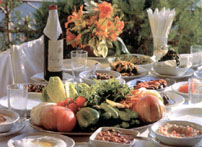 the authentic Lebanese lunch. Some
delicacies are always present in a mezze,
including the
internationally known tabboule salad. You will also find hommos-
a chickpea purée with sesame paste and babaganouj -- a
dip made of roasted eggplant, sesame paste, lemon and garlic. Raw
Kebbah -- fresh raw lamb pounded with ground wheat and seasoned with
onion, mint, pepper and salt is also a
favorite.
the authentic Lebanese lunch. Some
delicacies are always present in a mezze,
including the
internationally known tabboule salad. You will also find hommos-
a chickpea purée with sesame paste and babaganouj -- a
dip made of roasted eggplant, sesame paste, lemon and garlic. Raw
Kebbah -- fresh raw lamb pounded with ground wheat and seasoned with
onion, mint, pepper and salt is also a
favorite.The mezze is usually served without cutlery, for the traditional flat round Arab bread is both fork and spoon.
This substantial appetizer course is often accompanied by arak but Lebanon also produces some excellent beers and wines that go just as well.
In Lebanon there is no shortage of entertainment. You can dine in elegance on fine European cuisine or lunch at rustic riverside cafes. It is possible to enjoy floor shows at trendy nightspots or relax at a pub or bar. All kind of dancing are enjoyed, from the traditional Dabke to oriental or "belly dancing" and disco dancing. There are restaurants specializing in European and eastern cooking as well as innumerable establishments offering Lebanese food.
P R A C T I C A L I N F O
Visitors to Lebanon must have a valid passport and a Lebanese visa. Visas are delivered by Lebanese diplomatic missions abroad.
Customs
Examination of travelers' luggage is carried out rapidly and courteously. All ordinary personal effects are exempt from customs duty.
Getting There
All the world's great cities are linked by air with Beirut. The Beirut International Airport at Khaldeh (8 km from Beirut), is used by many international airlines plus the national carrier, Middle East Airlines (MEA). In addition, several steamship lines connect the ports of Beirut and Jounieh with the rest of the world.
Electric Current: 110 or 220 volts, 50 cycles. It's best to check.
Official Holidays
Thanks to diverse population and different religious groups, Lebanon has a full calendar of official holidays. Although all banks, government offices and schools are closed on these feast days, it is often possible to find some shops and restaurants open for business.
Language
In addition to his native Arabic language, the average Lebanese is often fluent in English or French. Many well-educated Lebanese are tri-lingual.
For more updated daily information about Lebanon visit Lebanon.com
VISIT THE CITIES OF
LEBANON
BEIRUT
- BAALBECK - TRIPOLI
- AANJAR - BYBLOS -
SIDON - JEITA
GROTTO
ZAHLE - THE CEDARS -
BEITEDDINE -
TYRE
